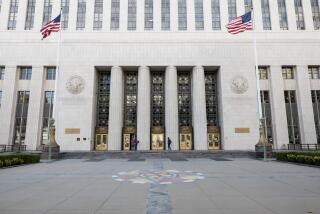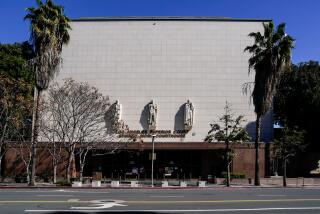Day in Court : Crowds Force Wheels of Justice to Turn Quickly
- Share via
Ramon Parra of Pacoima came to the San Fernando Courthouse’s arraignment court Tuesday to clear up a traffic ticket. But when his name was called once, then twice, and it was pronounced “Ray-mond” instead of “Rah-moan” both times, Parra didn’t realize that it was his turn.
If a translator had not stepped forward and pronounced the name correctly, it would have been too late--Commissioner Gerald Richardson would already have set Parra’s file aside and called the next case. Parra would have had to wait several hours until the end of the day when Richardson makes a second call of cases.
Court officials say a frenetic pace has become standard in San Fernando Municipal Court’s Division 130, one of the busiest courtrooms in the Los Angeles County court system. In something of a judicial assembly line, Richardson may process as many as 350 cases a day.
While other courts in the building usually close by 4:30 p.m., Richardson said he at times is still arraigning people at 6 p.m.
The division has seen a 40% increase in its daily caseload over last year. And to cope with the heavy flow of cases, Richardson arraigns people nonstop at a rate of one per minute.
The courtroom handles the arraignment for every case that comes to the San Fernando Courthouse--from minor traffic violations to misdemeanors to murders.
The high caseload also translates into crowding in the courtroom as scores of defendants, their families and friends wait for hours until their cases are called. On Monday, the Los Angeles Fire Department cited the courtroom as a fire hazard because of the crowding and blocked aisle exits.
“The volume of people coming here is ridiculous,” said court interpreter Paula Krawec. “We are overworked and overstressed, and we can’t even breathe.”
Many court officials say the daily caseload is too much for one courtroom and should be split up between two.
“There are courts that do half as many cases with twice as much staff,” said Bob Jason, a deputy public defender.
Traffic Cases
Traffic violators may soon be handled in a separate courtroom, court officials hope, which will take about 90 minutes worth of cases out of Division 130. Until then, however, they will continue to contribute to the general crowding of the facility.
The moment the doors opened at 8:45 a.m. Tuesday, a throng of people pressed though the narrow doorway into the courtroom.
Representing a cross-section of America, the defendants in Division 130 were all ages, races, creeds and economic levels. Many were dressed in grubby work clothes and baseball caps; a few wore expensive suits and carried briefcases.
“Every element of society comes through here, from rich businessmen who were speeding in their Mercedes on the freeways to the gang-bang murderers,” Richardson said.
All-Day Wait
Despite the differences that separated the defendants in the outside world, all were equal in Division 130. Each was ordered to the court at 9 a.m. and faced the prospect of an all-day wait. Those who were late and missed Richardson’s reading of their constitutional rights were asked to return the next day.
Several Spanish interpreters are always in court to translate for the dozens of Latino defendants who don’t speak English. On Tuesday, Richardson also called in Korean, Farsi and Arabic interpreters for other non-English-speaking defendants.
Richardson arraigned people one at a time, in case after case, taking pleas and dispensing verdicts.
The monotony was broken when Richardson arraigned 12 men at once. Each had been charged with driving under the influence of alcohol and each pleaded guilty. The entire procedure took less than five minutes.
Many defendants may be left bewildered by the brief proceedings, Richardson said. But “I give them a written copy of everything I said,” he said.
More to Read
Sign up for Essential California
The most important California stories and recommendations in your inbox every morning.
You may occasionally receive promotional content from the Los Angeles Times.













